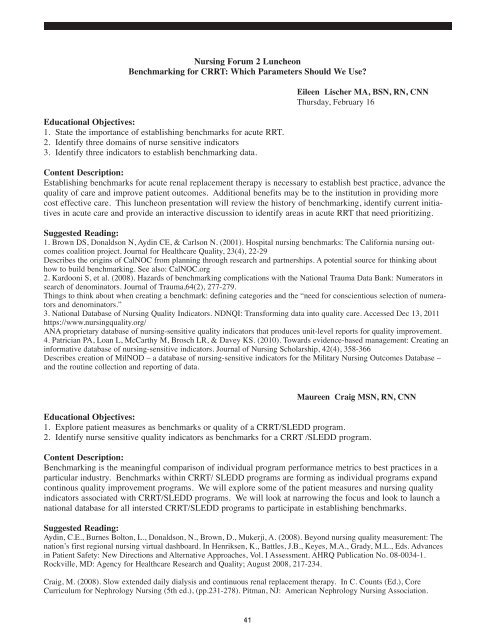ABSTRACTS from 16th International COnference on ... - CRRT Online
ABSTRACTS from 16th International COnference on ... - CRRT Online
ABSTRACTS from 16th International COnference on ... - CRRT Online
Create successful ePaper yourself
Turn your PDF publications into a flip-book with our unique Google optimized e-Paper software.
Nursing Forum 2 Lunche<strong>on</strong><br />
Benchmarking for <strong>CRRT</strong>: Which Parameters Should We Use?<br />
Educati<strong>on</strong>al Objectives:<br />
1. State the importance of establishing benchmarks for acute RRT.<br />
2. Identify three domains of nurse sensitive indicators<br />
3. Identify three indicators to establish benchmarking data.<br />
Eileen Lischer MA, BSN, RN, CNN<br />
Thursday, February 16<br />
C<strong>on</strong>tent Descripti<strong>on</strong>:<br />
Establishing benchmarks for acute renal replacement therapy is necessary to establish best practice, advance the<br />
quality of care and improve patient outcomes. Additi<strong>on</strong>al benefits may be to the instituti<strong>on</strong> in providing more<br />
cost effective care. This lunche<strong>on</strong> presentati<strong>on</strong> will review the history of benchmarking, identify current initiatives<br />
in acute care and provide an interactive discussi<strong>on</strong> to identify areas in acute RRT that need prioritizing.<br />
Suggested Reading:<br />
1. Brown DS, D<strong>on</strong>alds<strong>on</strong> N, Aydin CE, & Carls<strong>on</strong> N. (2001). Hospital nursing benchmarks: The California nursing outcomes<br />
coaliti<strong>on</strong> project. Journal for Healthcare Quality, 23(4), 22-29<br />
Describes the origins of CalNOC <str<strong>on</strong>g>from</str<strong>on</strong>g> planning through research and partnerships. A potential source for thinking about<br />
how to build benchmarking. See also: CalNOC.org<br />
2. Kardo<strong>on</strong>i S, et al. (2008). Hazards of benchmarking complicati<strong>on</strong>s with the Nati<strong>on</strong>al Trauma Data Bank: Numerators in<br />
search of denominators. Journal of Trauma,64(2), 277-279.<br />
Things to think about when creating a benchmark: defining categories and the “need for c<strong>on</strong>scientious selecti<strong>on</strong> of numerators<br />
and denominators.”<br />
3. Nati<strong>on</strong>al Database of Nursing Quality Indicators. NDNQI: Transforming data into quality care. Accessed Dec 13, 2011<br />
https://www.nursingquality.org/<br />
ANA proprietary database of nursing-sensitive quality indicators that produces unit-level reports for quality improvement.<br />
4. Patrician PA, Loan L, McCarthy M, Brosch LR, & Davey KS. (2010). Towards evidence-based management: Creating an<br />
informative database of nursing-sensitive indicators. Journal of Nursing Scholarship, 42(4), 358-366<br />
Describes creati<strong>on</strong> of MilNOD – a database of nursing-sensitive indicators for the Military Nursing Outcomes Database –<br />
and the routine collecti<strong>on</strong> and reporting of data.<br />
Maureen Craig MSN, RN, CNN<br />
Educati<strong>on</strong>al Objectives:<br />
1. Explore patient measures as benchmarks or quality of a <strong>CRRT</strong>/SLEDD program.<br />
2. Identify nurse sensitive quality indicators as benchmarks for a <strong>CRRT</strong> /SLEDD program.<br />
C<strong>on</strong>tent Descripti<strong>on</strong>:<br />
Benchmarking is the meaningful comparis<strong>on</strong> of individual program performance metrics to best practices in a<br />
particular industry. Benchmarks within <strong>CRRT</strong>/ SLEDD programs are forming as individual programs expand<br />
c<strong>on</strong>tinous quality improvement programs. We will explore some of the patient measures and nursing quality<br />
indicators associated with <strong>CRRT</strong>/SLEDD programs. We will look at narrowing the focus and look to launch a<br />
nati<strong>on</strong>al database for all intersted <strong>CRRT</strong>/SLEDD programs to participate in establishing benchmarks.<br />
Suggested Reading:<br />
Aydin, C.E., Burnes Bolt<strong>on</strong>, L., D<strong>on</strong>alds<strong>on</strong>, N., Brown, D., Mukerji, A. (2008). Bey<strong>on</strong>d nursing quality measurement: The<br />
nati<strong>on</strong>’s first regi<strong>on</strong>al nursing virtual dashboard. In Henriksen, K., Battles, J.B., Keyes, M.A., Grady, M.L., Eds. Advances<br />
in Patient Safety: New Directi<strong>on</strong>s and Alternative Approaches, Vol. I Assessment. AHRQ Publicati<strong>on</strong> No. 08-0034-1.<br />
Rockville, MD: Agency for Healthcare Research and Quality; August 2008, 217-234.<br />
Craig, M. (2008). Slow extended daily dialysis and c<strong>on</strong>tinuous renal replacement therapy. In C. Counts (Ed.), Core<br />
Curriculum for Nephrology Nursing (5th ed.), (pp.231-278). Pitman, NJ: American Nephrology Nursing Associati<strong>on</strong>.<br />
41
















